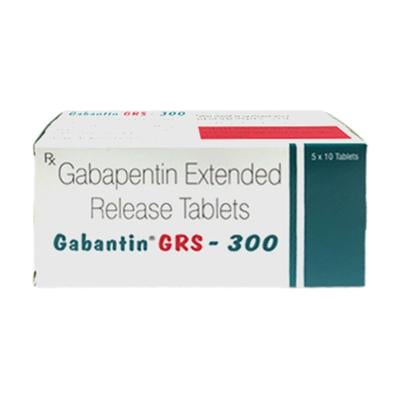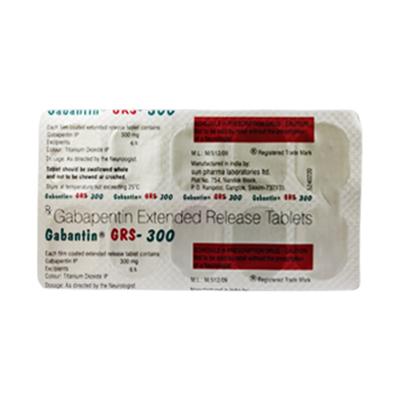

Netmeds First Membership
Quick Links
Introduction About GABANTIN GRS 300 TABLET
GABANTIN GRS 300 TABLET is used in the management of various forms of epilepsy alone or in combination with other medicine and manages peripheral neuropathic pain.
It contains Gabapentin which is an anticonvulsant agent that controls seizures and neuropathic pain by altering the electrical activity in the brain.
GABANTIN GRS 300 TABLET should be used under medical supervision only. Do not stop taking GABANTIN GRS 300 TABLET suddenly, as this may lead to increased risk of seizures.
This medicine should be used with caution patients having kidney problems, are on hemodialysis, muscle pain and/or weakness, suffer with different types of seizures including absences, persistent stomach pain, feeling sick and being sick (symptoms of inflamed pancreas), history of drug dependence or abuse, intolerance to certain sugar, have nervous system or respiratory disorders.
GABANTIN GRS 300 TABLET is not recommended for use in pregnant and breastfeeding women. It is not recommended for use in children aged below 6 years and should be used with caution in elder patients 65 years of age and above.
One of the serious side effects associated with GABANTIN GRS 300 TABLET is self-harming thoughts, contact your doctor immediately if you experience such unusual reactions. The most common side effects of taking GABANTIN GRS 300 TABLET are dizziness, drowsiness, blurred vision, viral infection, lack of coordination.
Uses Of GABANTIN GRS 300 TABLET
It is used to manage:
How GABANTIN GRS 300 TABLET Works
GABANTIN GRS 300 TABLET works effectively by altering the electrical activity in the brain by inhibiting the voltage-gated calcium channels and decreasing the release of excitatory neurotransmitters, thus managing fits or seizures. It also blocks the pain signals travelling through the damaged nerves and the brain and manages nerve pain.
How to use GABANTIN GRS 300 TABLET
Take GABANTIN GRS 300 TABLET as directed by your physician. Swallow it as whole with a glass full of water. Do not crush or chew the medicine. Correct dosage and duration will be prescribed by your doctor depending upon your age, body weight, and health condition.
Side Effects Of GABANTIN GRS 300 TABLET
Common Side Effects of GABANTIN GRS 300 TABLET:
- Fever, Chills, Runny nose, Cough
- Drowsiness, Dizziness
- lack of coordination, Tiredness
- Pneumonia
- Signs of upper respiratory tract infection (sore throat, inflamed sinuses, common cold)
- Signs of urinary tract infection (bladder pain, foul smell, cloudy urine, frequent urination)
- Inflammation of the ear or other infections
- Eating disorder characterized by low body weight and increased appetite
- Anger towards others, confusion, mood changes, depression, anxiety, nervousness, difficulty with thinking
- Jerky movements, difficulty with speaking, loss of memory, tremor, difficulty sleeping, headache, sensitive skin, decreased sensation (numbness), difficulty with coordination, unusual eye movement, increased, decreased or absent reflexes
- Blurred or double vision
- High blood pressure, flushing
- Difficulty in breathing, bronchitis
- Vomiting, nausea
- Problems with teeth, inflamed gums
- Diarrhea, stomach pain, indigestion, constipation, flatulence
- Joint pain, back pain, twitching
- Difficulties with erection (male)
- Swelling in the legs and arms, difficulty with walking, weakness, pain,
Stop taking GABANTIN GRS 300 TABLET and contact your doctor immediately if you experience any of the following side effects:
- Yellowing of your skin or of the whites of the eyes
- Unusual bruising or bleeding
- Severe weakness
- Unexplained muscle pain
- Frequent infections
Warning & Precautions
Pregnancy
Monitoring requiredGABANTIN GRS 300 TABLET is not recommended for use in pregnant woman or women planning to have a baby unless prescribed by your doctor. Effective contraception must be used by women of child-bearing potential.
Breastfeeding
ContraindicatedGABANTIN GRS 300 TABLET is not recommended for use in breast-feeding women as it may pass through breast milk.
Driving and Using Machines
Use with CautionDo not drive or operate any machines, because GABANTIN GRS 300 TABLET may cause dizziness, drowsiness and tiredness.
Kidney
Use with CautionGABANTIN GRS 300 TABLET should be used with caution in patients with kidney problems or undergoing hemodialysis.
Allergy
ContraindicatedDo not take GABANTIN GRS 300 TABLET if you are allergic to Gabapentin or any other ingredients of this medicine.
Use In Pediatrics
ContraindicatedGABANTIN GRS 300 TABLET is not recommended for use in children aged below 6 years.
Use In Geriatrics
Use with CautionGABANTIN GRS 300 TABLET should be taken with caution in elderly patients aged 65 years or above. The dose will be adjusted by your doctor.
Others
Before taking GABANTIN GRS 300 TABLET, inform your doctor if you:
- Have acute pancreatitis with signs of persistent stomach pain, feeling sick and being sick)
- Have nervous system disorders, respiratory disorders
- Have muscle pain and/or weakness
- Suffer with different types of seizures including absences
- Have history of drug dependence or abuse
- Have intolerance to certain sugars
Interactions
A. Drug-Drug interactions:
Before taking GABANTIN GRS 300 TABLET inform your doctor if you are taking any of the following medicines:
- Medicines containing opioids such as morphine (used to manage pain)
- Antacids such as aluminum hydroxide and magnesium hydroxide (medicines used to reduce heart burn, indigestion)
- Other medicines for convulsions (Ex. carbamazepine, phenytoin)
- Sleeping disorders (Ex. benzodiazepines)
- Depression, anxiety (Ex. fluoxetine)
Overdosage:
If you or anyone else accidentally takes too much of GABANTIN GRS 300 TABLET, consult your doctor immediately or visit the nearby hospital. Signs of overdose includes loss of consciousness, dizziness, double vision, slurred speech, drowsiness, tiredness, and diarrhoea.
Synopsis
| Drug | : | Gabapentin |
| Pharmacological Category | : | Anticonvulsants |
| Therapeutic Indication | : | Epilepsy, Peripheral neuropathic pain |
| Dosage Forms | : | Tablet, Capsule |
FAQs About GABANTIN GRS 300 TABLET
Q: What is GABANTIN GRS 300 TABLET and why is it given?
A: GABANTIN GRS 300 TABLET contains Gabapentin which is an Antiepileptic. GABANTIN GRS 300 TABLET is used to manage epilepsy (fits) and peripheral neuropathic pain (long term pain caused by damage to the nerves).
Q: How does GABANTIN GRS 300 TABLET work?
A: GABANTIN GRS 300 TABLET works effectively by altering the electrical activity in the brain by inhibiting the voltage-gated calcium channels and decreasing the release of excitatory neurotransmitters, thus managing fits or seizures. GABANTIN GRS 300 TABLET also blocks the pain signals travelling through the damaged nerves and the brain and manages nerve pain.
Q: How to take GABANTIN GRS 300 TABLET be?
A: Take GABANTIN GRS 300 TABLET as directed by your physician. Swallow it as whole with a glass full of water. Do not crush or chew the medicine. Correct dosage and duration will be prescribed by your doctor depending upon your age, body weight, and health condition.
Q: Can GABANTIN GRS 300 TABLET be stopped on our own?
A: Do not stop taking GABANTIN GRS 300 TABLET suddenly on your own, as it may lead to increased risk of seizure. Continue to take this medicine, as long as your doctor tells you to do so, to obtain better results.
Q: Is GABANTIN GRS 300 TABLET safe in pregnant and breast-feeding women?
A: GABANTIN GRS 300 TABLET is not intended for use in pregnant woman unless recommended by your doctor and in breast-feeding woman as it may pass through breast milk to the baby. Consult your doctor about the risk and benefits before taking GABANTIN GRS 300 TABLET.
Q: Is GABANTIN GRS 300 TABLET safe for use in elderly patients?
A: GABANTIN GRS 300 TABLET is suitable for use in elderly patients aged 65years and above. Correct dosage and duration will be prescribed by your physician. Consult your doctor before taking GABANTIN GRS 300 TABLET.
Q: Does GABANTIN GRS 300 TABLET causes dizziness?
A: Yes, GABANTIN GRS 300 TABLET may cause dizziness. Lie, or sit down immediately when you feel dizzy. If you're feeling a severe episode of vertigo, lie in a dark and quite place with eyes closed. Talk to your doctor if the symptom does not improve.
References
1. KD. Tripathi. Antiepileptics. Essentials of medical pharmacology. Eighth edition. 2019. Page – 439-442.
2. Mariangela Panebianco, Sarah Al-Bachari, Jennifer Weston, Jane L Hutton, Anthony G Marson, Cochrane Epilepsy Group. Gabapentin add-on treatment for drug-resistant focal epilepsy. National Library of Medicine, National center for biotechnology information. PubMed Central. 2018. [Accessed 13th June 2022] click here
3. Rama Yasaei; Shravan Katta; Abdolreza Saadabad. Gabapentin. National Library of Medicine, National center for biotechnology information. May 2022. [Accessed 13th June 2022] click here
4. Accord, Barnstaple. Electronic Medicines Compendium (EMC). [Revised in May 2022]. [Accessed 13th June 2022] click here
5. APL Swift Services (Malta) Limited. Electronic Medicines Compendium (EMC). [Revised in January 2021] [Accessed 13th June 2022] click here









